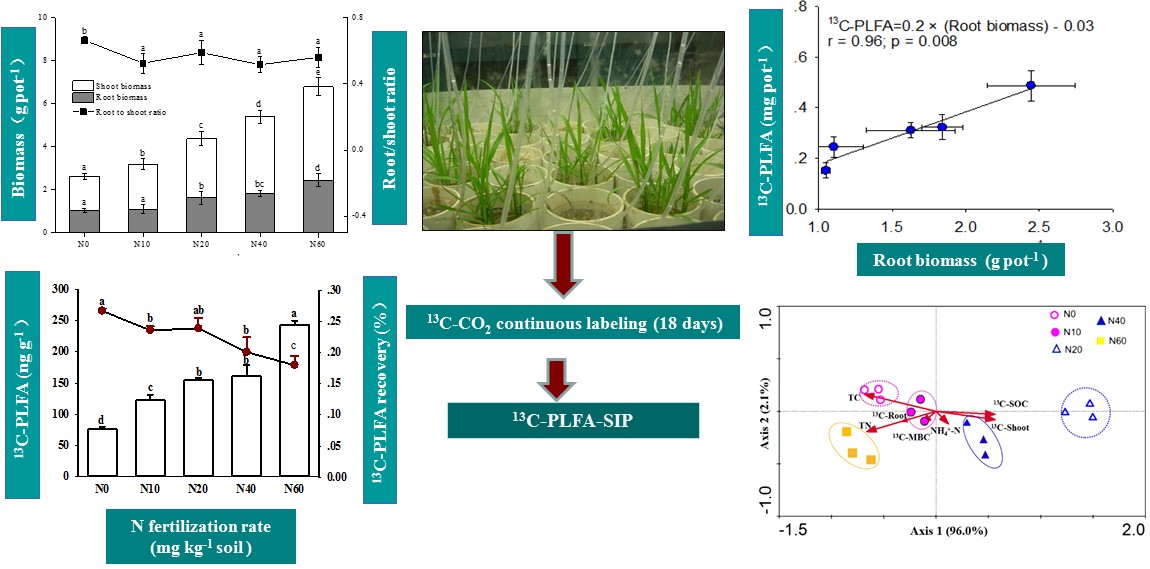- You are here: Home > Research > Research Progress
Rhizodeposited-C account for approximately 11% of all net photo-assimilates and represents a readily available source of C for soil microorganisms. This root-derived C plays a key role in soil nutrient cycling and the replenishment of SOM and thus strongly influences C sequestration in soil. Therefore, understanding the role of rhizosphere C flow and its ecological implications for paddy soils requires investigation into the mechanisms of root-derived C utilization by microbial groups and the fate of this C within functional SOM pools.
N fertilization has direct and indirect effects on microbial activity, community structure, and functioning. Changes in N availability are directly associated with shifts in microbial physiology and microbial community composition. Therefore, the research group from the Institute of Subtropical Agriculture, Chinese Academy of Sciences (ISA) performed 13C-CO2 continuous labeling (18 days) of rice plants grown in a paddy system under a range of N fertilization rates during the rice vegetative growth period (including the entire tillering stage. They hypothesized that first N fertilization increases total plant biomass and, as a result, increases belowground C allocation through the release of C from rice roots into the soil, second, rhizodeposit-C utilization by microbial groups depends on N fertilization because N availability affects microbial community structure and rhizodeposit composition, and third rhizodeposited-C in paddy soils is used mainly by bacteria because rice over-flooding and oxygen limitation negatively affects fungi.
The researchers found that N fertilization affected rice growth, rhizodeposition, SOM pools, and microbial group composition. Low to intermediate N rates resulted in higher 13C incorporation into soil and microorganisms than no or high N fertilization. The 13C incorporation into SOM, microbial biomass, and Phospholipid fatty acids (PLFAs) was positively correlated with rice root biomass. This provides a simple and important tool for estimating rhizodeposition under field conditions. Increased 13C incorporation into fungi with N fertilization rate suggests that fungi are important primary rhizo-C sinks in paddy ecosystems, even though the availability of oxygen in paddy soils is low. In contrast, G+ and G- bacteria took up less root-derived C at intermediate to high N fertilization rates than at no or low input rates.
They also found that N fertilization in rice production has a fundamental effect on biochemical and biological processes, including rhizodeposition. Rhizodeposition directly affects the activity and turnover rate of microbial groups. Therefore, intermediate N fertilization rates should contribute to greater C sequestration and decreased N pollution. Future investigation should focus on improvement of N use efficiency, reduction of N load in the environment and increasing C sequestration.
This study entitled "Rice rhizodeposition and its utilization by microbial groups depends on N fertilization" has been online in Biology and Fertility of Soils (doi:10.1007/s00374-016-1155-z). The full-text can be download at http://link.springer.com/article/10.1007/s00374-016-1155-z.
This study was supported financially by the National Natural Science Foundation of China (41671292;41522107) and Royal Society Newton Advanced Fellowship (NA150182).

Rice rhizodeposition and its utilization by microbial groups depends on N fertilization
Contact: GE Tida
E-mail: gtd@isa.ac.cn
Institute of Subtropical Agriculture, Chinese Academy of Sciences
Address: Mapoling of Changsha City, Hunan province, P.R.China.Tel: +86-731-4615204 Fax: +86-731-4612685

